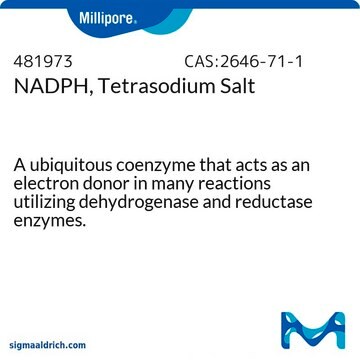19359
Glucose dehydrogenase from Pseudomonas sp.
powder, white, ≥200 U/mg
Synonym(s):
GDH
Sign Into View Organizational & Contract Pricing
All Photos(2)
About This Item
Recommended Products
biological source
bacterial (Pseudomonas spp.)
form
powder
specific activity
≥200 U/mg
greener alternative product characteristics
Waste Prevention
Design for Energy Efficiency
Learn more about the Principles of Green Chemistry.
sustainability
Greener Alternative Product
color
white
greener alternative category
, Enabling
storage temp.
−20°C
General description
We are committed to bringing you Greener Alternative Products, which adhere to one or more of The 12 Principles of Greener Chemistry. This product has been enhanced for energy efficiency and waste prevention when used in biofuel cell research. For more information see the article in biofiles.
Application
Glucose dehydrogenase from Pseudomonas sp. has been used for the oxidation of glucose as a part of flow-injection analysis detection. It has also been used to regenerate the consumed nicotinamide adenine dinucleotide (NADH) during the removal of pyruvate by lactate dehydrogenase.
Biochem/physiol Actions
In bacteria, the membrane integrated glucose dehydrogenase catalyses the conversion of glucose to gluconic acid. It uses pyrroloquinoline quinone as a coenzyme. The intracellular glucose dehydrogenase lack this cofactor. It is a nicotinamide adenine dinucleotide (NADH) dependent enzyme.
Unit Definition
One unit corresponds to the amount of enzyme which will oxidizes 1 μmole β-D-glucose to D-glucono-δ-lactone per minute at pH 8.0 and 37 °C
Storage Class Code
11 - Combustible Solids
WGK
WGK 3
Flash Point(F)
Not applicable
Flash Point(C)
Not applicable
Personal Protective Equipment
dust mask type N95 (US), Eyeshields, Gloves
Certificates of Analysis (COA)
Search for Certificates of Analysis (COA) by entering the products Lot/Batch Number. Lot and Batch Numbers can be found on a product’s label following the words ‘Lot’ or ‘Batch’.
Already Own This Product?
Find documentation for the products that you have recently purchased in the Document Library.
Basic Biotechnology, 370-370 (2006)
Rastislav Monošík et al.
Enzyme and microbial technology, 50(4-5), 227-232 (2012-03-16)
Amperometric glucose biosensors utilizing commercially available FAD-dependent glucose dehydrogenases from two strains of Aspergillus species are described. Enzymes were immobilized on nanocomposite electrode consisting of multi-walled carbon nanotubes by entrapment between chitosan layers. Unlike the common glucose oxidase based biosensor
Interference in a glucose dehydrogenase-based glucose meter revisited.
Brian N Kelly et al.
Clinica chimica acta; international journal of clinical chemistry, 413(7-8), 829-830 (2012-02-04)
Busisiwe V Twala et al.
Enzyme and microbial technology, 50(6-7), 331-336 (2012-04-17)
The use of enzymes in industrial applications is limited by their instability, cost and difficulty in their recovery and re-use. Immobilisation is a technique which has been shown to alleviate these limitations in biocatalysis. Here we describe the immobilisation of
Akasit Siriphongphaew et al.
Applied microbiology and biotechnology, 95(2), 357-367 (2012-05-05)
Oxygenases-based Escherichia coli whole-cell biocatalyst can be applied for catalysis of various commercially interesting reactions that are difficult to achieve with traditional chemical catalysts. However, substrates and products of interest are often toxic to E. coli, causing a disruption of
Our team of scientists has experience in all areas of research including Life Science, Material Science, Chemical Synthesis, Chromatography, Analytical and many others.
Contact Technical Service








